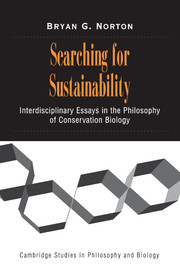Book contents
- Frontmatter
- Contents
- Searching for Sustainability
- General Introduction: An Interdisciplinary Experiment
- I PRAGMATISM AS AN ENVIRONMENTAL PHILOSOPHY
- II SCIENCE, POLICY, AND POLICY SCIENCE
- III ECONOMICS AND ENVIRONMENTAL SUSTAINABILITY
- 10 Sustainability, Human Welfare, and Ecosystem Health
- 11 Economists' Preferences and the Preferences of Economists
- 12 Evaluating Ecosystem States: Two Competing Paradigms
- 13 Sustainability: Ecological and Economic Perspectives, with Michael A. Toman
- 14 The Evolution of Preferences: Why ‘Sovereign’ Preferences May Not Lead to Sustainable Policies and What to Do about It, with Robert Constanza and Richard C. Bishop
- IV SCALING SUSTAINABILITY: ECOLOGY AS IF HUMANS MATTERED
- V SOME ELEMENTS OF A PHILOSOPHY OF SUSTAINABLE LIVING
- VI VALUING SUSTAINABILITY: TOWARD A MORE COMPREHENSIVE APPROACH TO ENVIRONMENTAL EVALUATION
- Index
- References
13 - Sustainability: Ecological and Economic Perspectives, with Michael A. Toman
Published online by Cambridge University Press: 21 January 2010
- Frontmatter
- Contents
- Searching for Sustainability
- General Introduction: An Interdisciplinary Experiment
- I PRAGMATISM AS AN ENVIRONMENTAL PHILOSOPHY
- II SCIENCE, POLICY, AND POLICY SCIENCE
- III ECONOMICS AND ENVIRONMENTAL SUSTAINABILITY
- 10 Sustainability, Human Welfare, and Ecosystem Health
- 11 Economists' Preferences and the Preferences of Economists
- 12 Evaluating Ecosystem States: Two Competing Paradigms
- 13 Sustainability: Ecological and Economic Perspectives, with Michael A. Toman
- 14 The Evolution of Preferences: Why ‘Sovereign’ Preferences May Not Lead to Sustainable Policies and What to Do about It, with Robert Constanza and Richard C. Bishop
- IV SCALING SUSTAINABILITY: ECOLOGY AS IF HUMANS MATTERED
- V SOME ELEMENTS OF A PHILOSOPHY OF SUSTAINABLE LIVING
- VI VALUING SUSTAINABILITY: TOWARD A MORE COMPREHENSIVE APPROACH TO ENVIRONMENTAL EVALUATION
- Index
- References
Summary
INTRODUCTION: ECOLOGISTS, ECONOMISTS, AND THE SEARCH FOR SUSTAINABLE POLICIES
Decision makers are more and more often being told to “act sustainably” and to pursue policy paths toward “sustainable development.” These admonitions and instructions appear to express a significant societal commitment to alter current practices. And yet these widely supported admonitions provide little guidance to policymakers and other actors, because the term “sustainable” embodies deep conceptual ambiguities. These ambiguities cannot be easily resolved because they rest, in turn, on serious theoretical disagreements that transcend disciplinary boundaries. In particular, economists and ecologists employ different conceptualizations for explaining the interactions of humans with their environment. Nor are these differences easily ignored because they pervasively affect the way we conceive and implement sustainable policies.
They also affect which data are gathered and considered relevant to policy decisions, and they dictate quite different approaches toward aggregation of data and the integration of information in the search for improved environmental policies. If we resolve to base environmental and economic policy on the best scientific evidence available – and we think most scientists and policy makers would agree, also, with this resolution – then it is essential that scientists co-operate across disciplines to encourage improved communication among disciplines and also improved communication of information from the various disciplines to decision makers. Data are just data; only “interpreted data” will affect the decision process. Who, then, will interpret the data and apply it in a decision process?
- Type
- Chapter
- Information
- Searching for SustainabilityInterdisciplinary Essays in the Philosophy of Conservation Biology, pp. 225 - 248Publisher: Cambridge University PressPrint publication year: 2002

